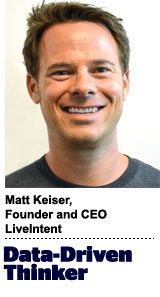 “Data-Driven Thinking” is written by members of the media community and contains fresh ideas on the digital revolution in media.
“Data-Driven Thinking” is written by members of the media community and contains fresh ideas on the digital revolution in media.
Today’s column is written by Matt Keiser, founder and CEO at LiveIntent.
In the heady days that preceded the first dot-com bust, we saw an inkling of the M&A fever that would define our modern era. The stories of frothy IPOs were legendary, illustrated by the likes of Pets.com and Webvan. But in one corner of the market, a bumpy acquisition was laying the foundation for the next 10 to 15 years of ad tech.
In 1999, Google had not yet acquired DoubleClick. As its own independent platform, DoubleClick saw the potential of combining its ad-serving capabilities with the data-collection expertise of Abacus – a very forward-thinking move. DoubleClick bought Abacus for $1.7 billion with visions of marshaling resources to fuel a powerhouse. What it didn’t envision was that the merger would haunt the industry for 15 years and create the dynamics that would make Facebook the preeminent leader in the newest, most powerful form of marketing: people-based marketing.
When DoubleClick purchased Abacus, it encountered a firestorm from privacy advocates, who worried that personally identifiable information (PII) would be tied to online info. It was the first time anyone in ad tech had faced mobilized consumer sentiment. DoubleClick did not have safeguards in place to easily ensure privacy and articulate those safeguards to the public. Although eventually cleared by the FTC, the privacy scare still stunted the acquisition. The DoubleClick and Abacus databases never merged but the reverberations were manifold.
The PixelTech Era
The conversation led to the Network Advertising Initiative, whose work helped us understand the difference between personally identifiable information and non-personally identifiable information: PII vs. non-PII. In our modern era, we rely on third parties to anonymize that data and make it PII-free.
What many don’t realize is that this aborted merger shook the industry off of its trajectory and ushered in a new era, which is only now coming to a close. I like to call it PixelTech.
PixelTech is best exemplified by the reliance, in the intervening years, on third-party cookies and pixels as the dominant identifiers in advertising and marketing. For years, companies like Google have wielded the power of ad tech almost exclusively within the confines of the cookie to decide which advertisement to serve and when.
PixelTech made a lot of people a lot of money for what was, in technology terms, an eternity. Companies like Google, Criteo, Rocket Fuel and BlueKai perfected the art of marketing to the cookie and reaped the rewards.
However, for as powerful as PixelTech was, the fact that it was the dominant tool for so long was a symptom of reticence across the industry. PixelTech was essentially the residue from DoubleClick’s travails. The result was an industrywide reluctance to pursue solutions that went beyond the cookie.
We now live in a world where the average consumer has multiple devices. Mobile has been a burgeoning force for quite some time. The technology industry is fully aware that a focus on PixelTech won’t cut it in the future. Mobile famously isn’t cookie-friendly. Multiple devices mean targeting a cookie lacks the same punch it once did.
The fact that the industry was in drastic need of a change from PixelTech was not news. What was news is what came along to rescue it from the doldrums.
The People-Based Marketing Era
Facebook burst onto the scene with groundbreaking achievements twice. Originally it came to market with Facebook Custom Audience, along with Twitter Tailored Audience.
Facebook made its second big move during the 2014 Advertising Week when it announced that it rejiggered Atlas to deliver the promise of a platform able to execute people-based marketing. The shift that Atlas represented was that now, marketing was extended beyond logged-in media. The Atlas innovation allowed for deidentified data to be used even when users were not logged in to the media in question.
Now, people-based marketing can be broken down into two camps: matching deidentified data and onboarding. Facebook and Twitter fit into the former category since brands can pass deidentified data to the platforms for targeting when users of both services are logged in.
In contrast, companies like Criteo, AOL and Google rely on companies like LiveRamp, Neustar and Oracle/DataLogix to onboard the data needed for people-based marketing. The onboarding process links deidentified PII to a cookie or mobile ID for the purposes of targeting and retargeting. The process is one-way; you can only go from PII to non-PII with very few exceptions.
Why Facebook?
Why did this change in approach to people-based marketing take so long? The technology has been there. The industry has changed in the years since the Abacus uproar. The industry has developed and is meeting guidelines around the use of data.
Yet, it took awhile for such a bold move. Why was Facebook the one to make it?
A very simple explanation: Mark Zuckerberg’s age. Facebook’s CEO and founder is only 31. He was in his teens during the first dot-com bust. As precocious as he was, I imagine he wasn’t versed in the nuances of ad tech at that age. Those who lived through that first dot-com bust experienced the cautionary tale of Abacus emotionally. The memory caused an entire industry to be reticent to the point that it didn’t go after people-based marketing despite how necessary and obvious it was.
The industry had the ability to deidentify PII for a significant amount of time, yet it still focused on the cookie knowing of its serious limitations.
Facebook released Atlas in September, ushering in the era of marketing to people across devices and channels, not pixels. Its technology underscored how the cookie was crumbling and signaled that the next generation of marketing would be focused on using first-party data to find the right customer where they’re paying attention.
The company that broke through and kick-started people-based marketing is a business-to-consumer offering. It didn’t have to be Facebook. There were other candidates that could have, with simple acquisitions here or there, followed in DoubleClick’s prescient footsteps back in 1999 when it attempted to integrate with Abacus. Other players could have created the dominant people-based marketing solution. These days, deidentifying PII is standard practice and consumer privacy is the top priority for everyone, yet Facebook threw its hat into the ring first.
What’s Next?
In recent months, we’ve seen AOL, Criteo Twitter and other companies make serious forays into people-based marketing. Facebook may have been the first, but I don’t believe it will emerge as the dominant force.
Things change. DSPs and SSPs replaced ad exchanges. Google was once the hero and first mover when RTB entered the scene, giving it the upper hand. Today, it appears AOL and Criteo are moving the fastest of the scaled players when it comes to entering the people-based marketing space.
So as the PixelTech era comes to an end, we’re left with many questions. Will Google live up to its reputation for brilliance and catch up by making smart acquisitions? Will new players emerge to rival the incumbent class? Will those on top during the people-based marketing era be stagnant or continue to innovate?
Follow Matt Keiser (@mrkeiser), LiveIntent (@LiveIntent) and AdExchanger (@adexchanger) on Twitter.












